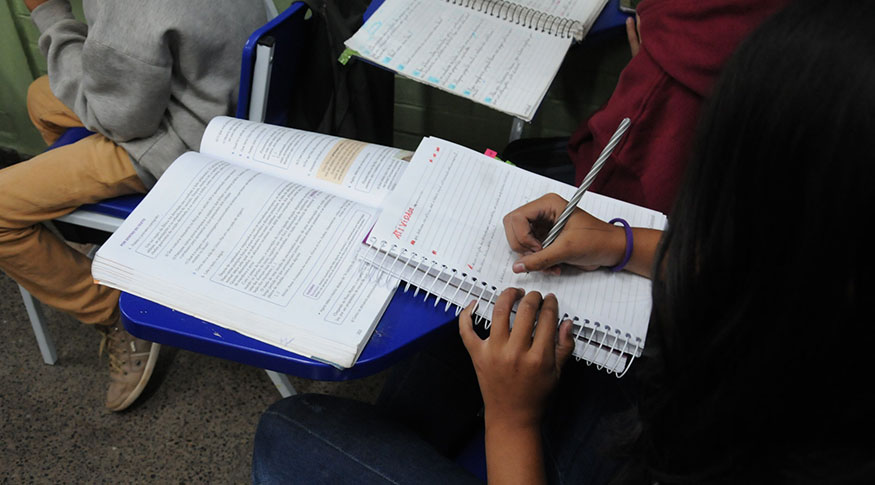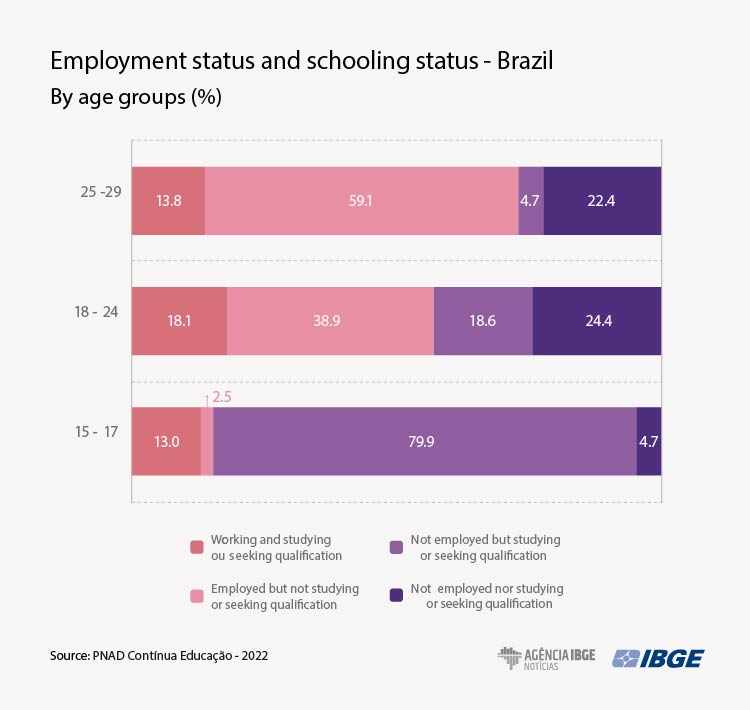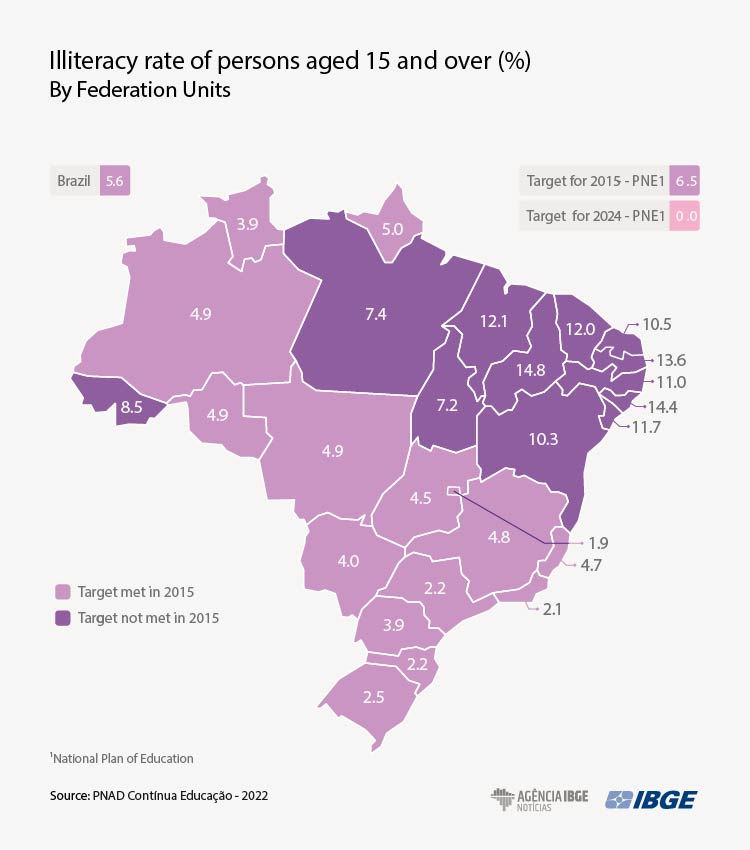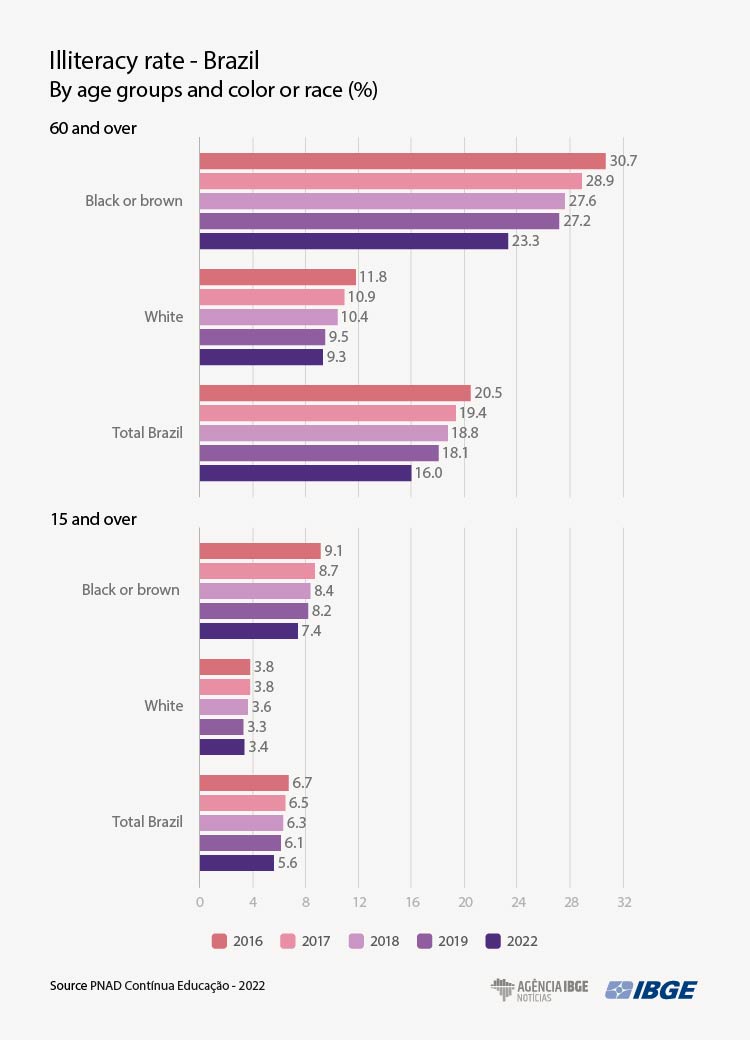Continuous PNAD
Illiteracy rate is lower in 2022, but remains high among the elderly, black and brown persons and in the Northeast Region
June 07, 2023 10h00 AM | Last Updated: June 09, 2023 11h41 PM
Highlights
- Illiteracy rate went from 6.1% in 2019 to 5.6% in 2022. The Northeast recorded the highest rate (11.7%) and the Southeast, the lowest (2.9%). Among the elderly (60 and over), the difference between the rates was even higher: 32.5% for the Northeast and 8.8% for the Southeast.
- Of the 9.6 million persons aged 15 and over who were not able to rear or write, 59.4% (5.3 million) lived in the Northeast and 54.1% (5.2 million) were 60 years of age and over.
- Among the Federation Units, the three highest illiteracy rates were those of Piauí (14.8%), Alagoas (14.4%) and Paraíba (13.6%) and the lowest, those of the Federal District (1.9%), Rio de Janeiro (2.1%) and São Paulo and Santa Catarina (both with 2.2%).
- Among black or brown persons aged 15 and over, 7.4% were illiterate, more than twice the rate registered among white persons (3.4%). In the age group of persons 60 and over, the illiteracy rate of white persons was 9.3%, whereas among blacks or browns it reached 23.3%.
- For the first time, more than half (53.2%) of the population aged 25 had completed, at least, compulsory basic education, that is, at least high school. Among black or brown persons, this percentage hit 47%, whereas among white ones, the proportion was 60.7%.
- From 2019 to 2022, the schooling rate of children aged 4 to 5 fell from 92.7% in 2019 to 91.5% in 2022.
- The schooling rate of the population remained high at 99.4%, but the adjusted net attendance rate – which considers age/phase adequacy – fell from 97.1% in 2019 to 95.2% in 2022 and reached the lowest level in the series that started in 2016.
- The schooling rate of persons aged 15 to 17 rose from 89.0% in 2019 to 92.2% in 2022. The proportion of those taking the adequate school phase, attending, or having completed secondary education, also increased, and went from 71.3% in 2019 to 75.2% in 2022.
- In the population aged 18 to 24 anos, 36.7% of the white persons were studying, whereas among black and brown persons the rate was 26.2%. Considering white persons, in this age group attending school, 29.2% were in higher education, versus 15.3% of black or brown ones. Also, 70.9% of the black and brown persons at this age were not studying nor had finished higher education, whereas, among men, that percentage was 57.3%.
- In 2022, the public education system encompassed a total of 77.2% of the students in nursery school and preschool; 82.5% of those in primary school and 87.1% of those in regular high school. The private education system encompassed 72.6% of the students in higher education and 75.8% of those taking postgraduate studies.
- About 18.3% of the youngsters aged 14 to 29 did not finish high school, either because of dropout or because they had never attended school.
- The necessity to work was the main reason reported by youngsters aged 14 to 29 to drop out of school, a total of 40.2%.
- Among the 49 million persons aged 15 to 29 in Brazil, 20.0% were neither employed nor studying; 15.7% were employed and studying; 25.2% were not employed but were studying and 39.1% were employed but not studying.

The illiteracy rate of persons aged 15 and over fell from 6.1% in 2019 to 5.6% in 2022, a drop by a little more than 490 thousand illiterate persons in the country, leading to the lowest rate in the series that started in 2016. A total of 9.6 million persons were not able to read or write, with 55.3% (5.3 million) of them in the Northeast and 54.2% (5.2 million) were 60 years of age and over.
The data came from the Continuous National Household Sample Survey - Continuous PNAD: Education 2022, released today by the IBGE. This is the first release of the module after the pandemic. Due to the reduction in the sample utilization rate, caused by a change in the form of collection implemented on an urgent basis during the social distancing period, the release of this volume was halted in 2020 and 2021, and it was resumed with results for 2022.
“Illiteracy remains on a downward trend, but keeps a structural characteristic: the older the population group, the highest the proportion of illiterate persons. That indicates younger generations have had higher access to education and are being taught how to read and write during childhood, whereas here is a group of illiterate persons who is mostly formed by elderly persons who had no access to literacy classes as children/youngsters and remained illiterate in adult life,” says Adriana Beringuy, head of the IBGE’s Household Sample Surveys.
As taxas ficaram em 16,0% entre as pessoas de 60 anos ou mais, 9,8% entre as pessoas com 40 anos ou mais, 6,8% entre aquelas com 25 anos ou mais e 5,6% entre a população de 15 anos ou mais. Por outro lado, a taxa de analfabetismo das pessoas de 60 anos ou mais foi a que mais caiu, reduzindo-se em 2,1 p.p frente a 2019 e 4,5 p.p. ante 2016.The rates were 16.0% among persons aged 60 and over; 9.8% among those aged 40 and over; 6.8% among persons 25 years of age and over and 5.6% in the population 15 years of age and over. On the other hand, the illiteracy rate of persons aged 60 and over recorded the steepes decrease, by 2.1 percentage points (p.p.) from 2019 and 4.5 p.p. from 2016.
Illiteracy rate of blacks and browns is twice as that of white persons
In 2022, among black and brown persons aged 15 and over, 7.4% were illiterate, more than twice the rate for white persons (3.4%). In the group aged 60 and over, the illiteracy rate of white persons reached 9.3%, whereas, among black and brown ones, 23.3%.
In the analysis by sex, the illiteracy rate of women aged 15 and over, in 2022, was 5.4%, whereas that of men was 5.9%. Among elderly persons, the rate of women was 16.3%, exceeding that of men, 15.7%.

Ms. Beringuy highlights that “the trend to decrease of illiteracy is observed in groups where it is higher: the older population and black and brown persons. It is as if there were more rool for decrease in these groups, once the young population has reached a higher level of schooling. The overall scenario shows that more than 20% of the black and brown persons aged 60 and over are still illiterate.”
Illiteracy rate in the Northeast is four times that in the Southeast
The illiteracy rate of persons aged 15 and over also reflects regional inequalities: the Northeast has the highest rate (11.7%) and the Southeast, the lowest (2.9%). Among the elderly (60 years of age and over), the difference is even higher: 32.5% in the Northeast and 8.8% in the Southeast.
“The illiteracy rate is one of the targets of the National Plan of Education (PNE), which will be into effect until 2024. One of the items would be the reduction of the rate for the population aged 15 and over to 6.5% in 2015 and erradication in 2024. The intermediate target was met in 2017 for the Brazil- averag. However, in the Northeast and for the black and brown population it has not been met yet,” the coordinator explains.

Among the 27 Federation Units, the ones recording highest illiteracy rates were Piauí (14.8%), Alagoas (14.4%) and Paraíba (13.6%). The three lowest rates were those of the Federal District (1.9%), Rio de Janeiro (2.1%) and São Paulo and Santa Catarina (both with 2.2%).
In 2022, for the first time, more than 50% of the persons aged 25 and over in the country had completed basic education
In Brazil, the proportion of persons aged 25 and over who had completed at least compulsory basic education - that is - had completed at least high school – reached 53.2% in 2022, having exceeded, for the first time, the figure that had been reached in 2019. However, for black and brown persons, this percentage was 47.0%, whereas among white persons the proportion was 60.7%, a difference of 13.7 p.p.
“From 2016 to 2022, this difference by color or race reeuced a little – it was 16.6 p.p. in 2016 –, but remains at a high level, which indicates opportunities in education are distinct between the two groups. By Major Region, the differences are already known: The North and Northeast have less than half of the population aged 25 and over who at least completed basic education, whereas the Southeast is at 59%,” says Ms. Beringuy.
Percentage of persons aged 25 years of age and over with incomplete primary education decreases
The groups with incomplete or complete primary education recorded decreases between 2019 and 2022, whereas the other groups recorded increases. The percentage of persons who completed higher education stands out: it rose from 17.5% in 2019 to 19.2% in 2022; those who completed high school changed from 28.3% to 29.9%, whereas the percentage of persons with incomplete primary education fell by 3.2 p.p. no in the period (from 31.2% to 28.0%).
Average number of years of schooling of women is higher than men’s
The average number of years of schooling of persons aged 25 and over was 9.9 years in 2022, with an increase of 0.3 years against 2019. Women had, on average, 10.1 years of schooling and men, 9.6 years. By color or race, once more the difference was considerable: 10.8 years of schooling for white persons and 9.1 for black and brown persons.
Public education system is predominant from nursery care to high school
In 2022, 77.2% of the students in nursery school and preschool were in the public education system; the same was true for 82.5% of the students in regular primary school and 87.1% of those in regular high school. The private sector was responsible for 72.6% of the students in higher education and 75.8% of those in postgraduate courses.
“The public sector is the main responsible for basic education in Brazil, with municipalities and states as the main providers of regular primary and secondary education,” Ms. Beringuy highlights.
Parents’ choice is the main reason for non-attendance to school of children aged 0-3
In Brazil, in 2022, 9.6 million children aged 0 to 5 were attending school or nursery school. Among children aged 0 to 3, the schooling rate was 36.0%, which is equivalent to 4.1 million students, a stable percentage against 2019 and 5.7 p.p. higher than in 2016.
In these age groups, the main reason for non-attendance to nursery school was a choice or parents or guardians, for 60.7% of the children aged 0-1 and 51.3% of the children aged 2-3. In all the Major Regions that was the most reported reason. The second most often mentioned reason was the non-existence of a nursery school/school in the location, lack of vacancies or non-acceptance by the school: 31.7% (children aged 0-1) and 39.7% (children aged 2-3).
Schooling rate of children aged 4-5 decreases
Between 2019-2021, the schooling rate of children aged 4-5 fell from 92.7% in 2019 to 91.5% in 2022. This decrease occurred although basic education from 4 years of age on has been compulsory since 2013, with a progressive adaptation of municipal and state education systems to adjust and receive students aged 4-17.
The Northeast has had the higher percentage of children in this age group since 2016, reaching 93.6% in 2022. The Southeast and South exceeded 90%, whereas the North and Central West remained below the national average, with 82.8% and 87.9%, respectively.
In 2022, percentage of children aged 6 to 14 at the adequate school level was the lowest since 2016
In the group aged 6-14, the universalization of education has been virtually reached since 2016, with the school rate in Brazil having reached 99.4% in 2022. The levels are high in all the Major Regions, mainly in the Southeast (99.6%).
“These results show the importance of a public policy for compulsory provision of education for this age group, being this level - primary school - mainly offered by municipal schools, thus resulting in a high schooling rate,” the department head explains.
However in the same age group, the adjusted rate of net school attendance - which considers the adequate age/level – fell from 97.0% in 2019 to 95.2% in 2022, lowest level in the series, since 2016.
“The decrease was mainly due to the group aged 6-10, persons who should be in the early ages of primary school. This movement may be related to some difficulty in the transition of younger children from the previous level, preschool, into primary school.”
School attendance rate of youngster aged 15-17 increases
The schooling rate of persons aged 15-17 increased from 89.0% in 2019 to 92.2% in 2022, being above 90% for the first time in the series. The increases the Southeast Region (5.0 p.p), North (3.3 p.p.) and Northeast (3.1 p.p.) stand out, with stability in the South. The proportion of persons who were taking the adequate level, that is, attending high school, increased from 71.3% in 2019 to 75.2% in 2022.
“In this age group, the increase of the adjusted net attendance rate is a significant advance, since, at this elevel there is usually increase of school dropout. However, the expansion of this indicator points to a longer permanence of these youngsters in school.”
Although there are lower adjusted net attendance rates, the North (68.1%) and Northeast (69.3%) registered the most significant advances (5.9 p.p. and 6.0 p.p., respectively). The lowest recorded the lowest increase, in spite of having registered the highest rate, 81.5%.
A highlight is the difference in the rates adjsuted by sex and color or race: 79.7% for women and 71.0% for men, a difference of 8.7 p.p.; and 80.8% for white persons, and 71.7% for black or brown persons, adifference of 9.1 p.p. It is worth mentinong the advance of 5.0 p.p. for black or brown persons against 2019.
70.9% of blacks and browns aged 18-24 left school without completing higher education
In 2022, about 30.4% of the persons aged 18-24 were studying, with 20.8% attending higher education courses an 10.3% delayed in school, still attending basic education. In the same age group, 4.1% were no longer attending school, but had already finished higher education. On the other hand, 65.5% of the youngsters at this age had already left school without finisinh higher education.
A bigger percentage of women in this age group were attending school (32.6% versus 28.1% of men); 24.0% of them were undergraduate students and 5.0% had completed this level, whereas, among men, these percentages were, respectively, 17.2% and 3.3%. Besides more delay (10.9%), 68.5% of the men aged 18-24 were not attending school, although they had not completed higher education.
The scenario by color or race shows even more inequality: 36.7% of the white persons aged 18- 24 were attending school, whereas, among blacks and browns, that rate was 26.2%. Among white persons who attended school, 29.2% were taking undergraduate courses, whereas among blacks and browns the percentage was 15.3%.
In this age group, 6.0% of the white youngsters had an undergraduate certicicate and, considering black or brown students, only 2.9% did. Another highlight was that 70.9% of the blacks and browns were neither attending or had completed higher education, whereas, among white ones, that percentage was 57.3%.
“The target for PNE establishes that the net attendance rate in higher education for the population aged 18-24 reach 33% by 2024. In 2022, in Brazil, this target had been reached only among white persons (35.2%). The challenge for our country is to reduce inequalities in access to higher education, besides fighting the school delay of these students,” says Ms. Beringuy.
School dropout increases among youngters aged 15 and over
Of the 52 million youngsters aged 14 to 29 in the country, 18.3% did not complete high school, either because they left school before the end of this level of never attended it. Brazil had 9.5 million youngsters aged 14 to 29 in this situation, being 58.8% of men and 41.2% of women. In terms of color or race, 27.9% of these youngsters were white and 70.9% were black or brown.
Necessity to work is main reason for dropout
When asked about the main reason for having dropped out of or never attended school, 40.2% of the youngsters reported the necessity to work as the main factor. Among men, this figure increased to 51.6%. The lack of interest in studying is in the second position, with 26.9%. Among women, the main reason was also the necessity to work (24.0%), followed by pregnancy (22.4%) and lack of interest (21.5%). In addition to that, 10.3% of them reported doing household tasks or taking care of people as the main reason for having dropped out of school, whereas, among men, this percentage was insignificant (0.6%).

One out of every five youngsters were neither studying or working
In Brazil, in 2022, there were 49.0 milion persons aged 15-29. In this group, 15.7% were employed and studying; 20.0% were neither employed nor studying; 25.2% were not employed but were studuyng; and 39.1% were employed but not studying.
Among women, 25.8% were not employed or studying or seeking qualification and, among men, the percentage was 14.3%. On the other hand, 31.1% of the women and 46.9% of the men only worked, whereas 27.4% of the women and 23.1% only studied or sought qualification.
As for color or race, 18.8% of the white persons were working and studying, a bigger percentage than among black or brown persons (13.7%). The percentage of white persons who only worked (39.3%) or only studied (26.2%) also exceeded that of black or brown personse, whereas black or brown persons (22.8%) who were not studying or working exceed that of white persons (15.8%).

Among youngster aged 15-17, who were still at the compulsory school age, 79.9% were exclusively dedicated to school and 13.0% were studying and working. Among persons aged 18 to 24, 38.9% of the persons were only working and 24.4% were neither studying or seeking qualification. Considering those aged 25-29, 59.1% were only employed and 13.8% were employed and studying or seeking qualification. On the other hand, 22.4% of the persons in this group were neither employed nor studying or seeking qualification.




















